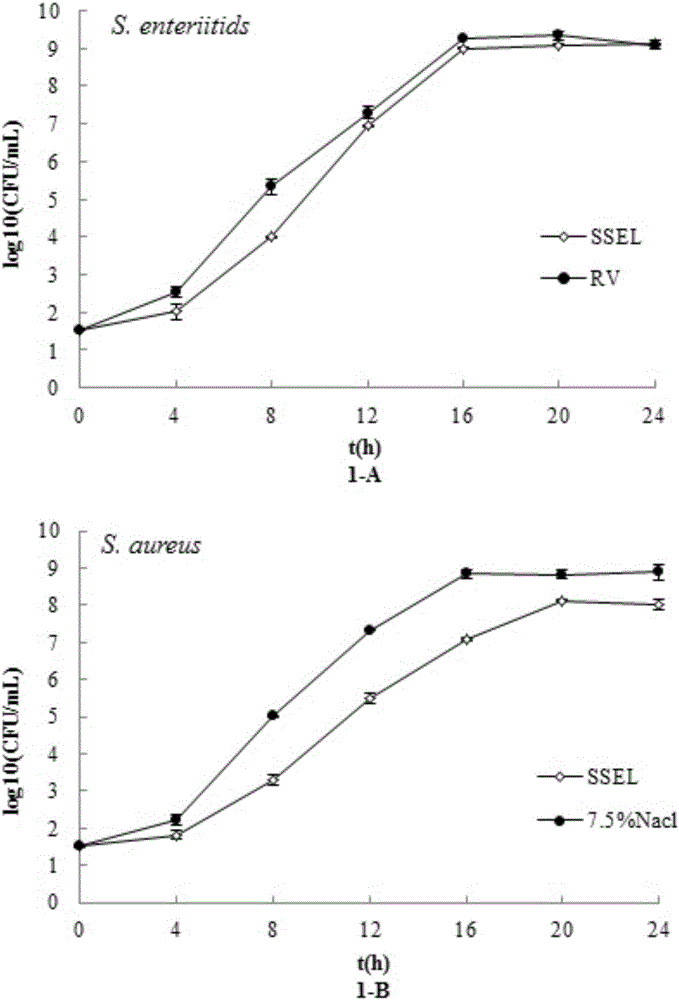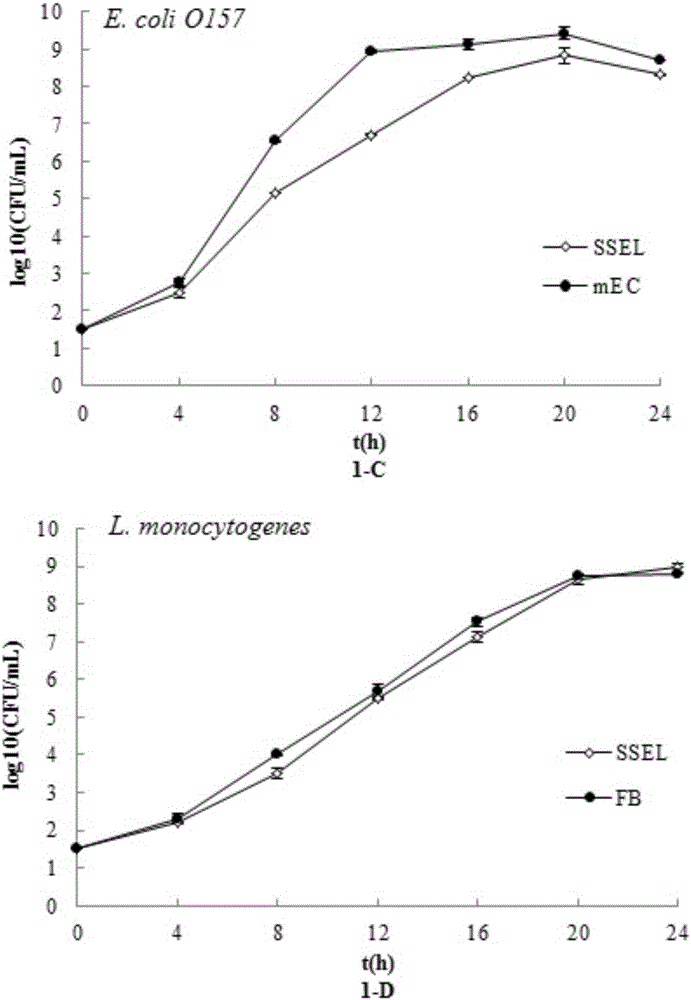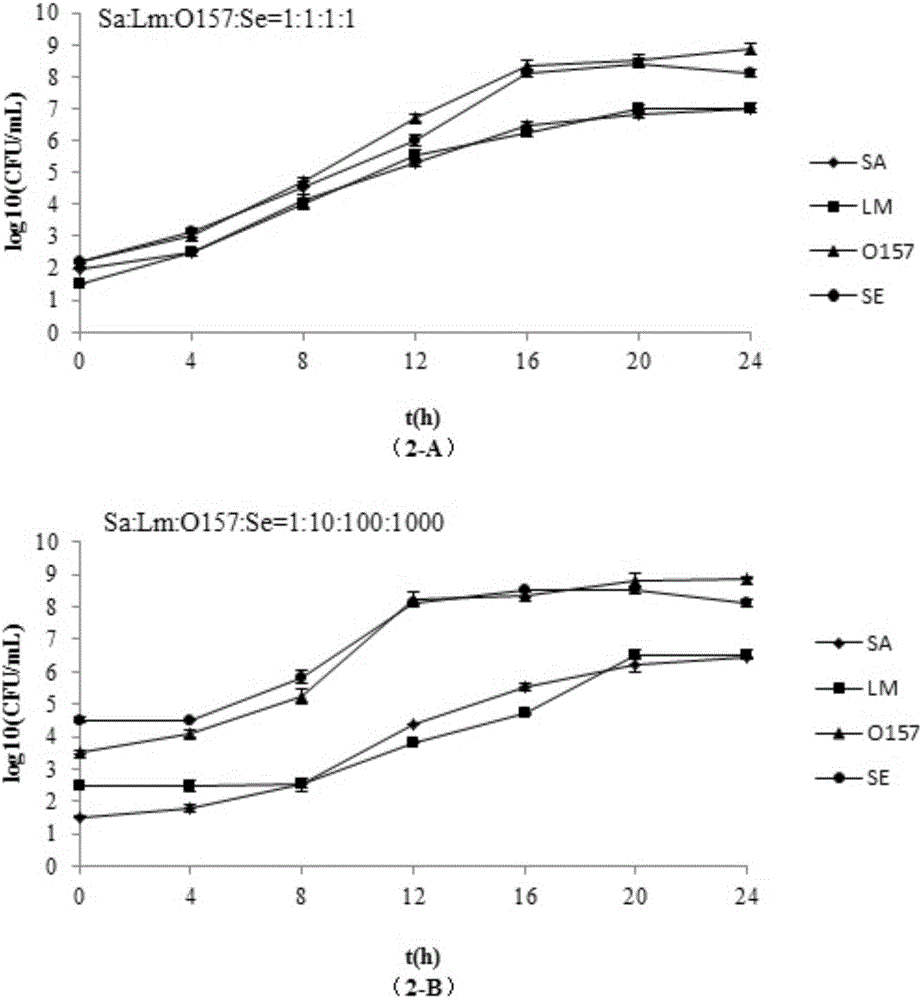Co-enrichment medium SSEL
A technology of enrichment medium and basic medium, which is applied in the field of agricultural product testing, to achieve the effect of testing a wide range of samples, avoiding the interference of miscellaneous bacteria, and saving quantity
- Summary
- Abstract
- Description
- Claims
- Application Information
AI Technical Summary
Problems solved by technology
Method used
Image
Examples
Embodiment 1
[0040] Example 1: Verification of the separate enrichment effect of the co-enrichment culture medium SSEL
[0041] Preparation of SSEL medium: Weigh 30 parts of tryptone soybean broth, 6 parts of yeast extract, 10 parts of sodium deoxycholate, and 15 parts of lithium chloride, add 1000 parts of deionized water, stir well, and heat at 121 ° C under high pressure Sterilize and cool to room temperature. Then, aseptically add 0.012 parts of acriflavine and 0.0025 parts of nalidixic acid, and stir evenly to prepare SSEL medium.
[0042] SSEL enrichment culture: 10 1 one 10 2 CFU / mL of Salmonella, Staphylococcus aureus, Escherichia coli O157:H7, and Listeria monocytogenes were inoculated into 100mL SSEL and their respective selective enrichment solutions (Salmonella: RV, Staphylococcus aureus: 7.5% sodium chloride In broth, Escherichia coli O157:H7:mEC+n, Listeria monocytogenes:FB), shake culture at 37°C for 24h, take the culture once every 4h, and use the selective isolation med...
Embodiment 2
[0043] Example 2: Verification of SSEL compound bacterial enrichment effect
[0044] Preparation of SSEL medium: refer to Example 1.
[0045] SSEL enrichment culture: Salmonella, Staphylococcus aureus, Escherichia coli O157:H7, and Listeria monocytogenes were respectively divided into 1:1:1:1 (10 2 CFU / mL), 1:10:100:1000 (10 1 one 10 4 CFU / mL), 10:1:1000:100, 100:1000:1:10, 1000:100:10:1 were mixed and inoculated into SSEL, cultured with shaking at 200rpm at 37°C for 24h, and the culture was taken every 4h , counted with the selective isolation medium of each target bacteria ( figure 2 ). from figure 2 It can be seen that when the inoculation amount of the four target bacteria is the same, Salmonella, Staphylococcus aureus, O157:H7 and Listeria monocytogenes grow well in SSEL, and the growth rate, lag period and stable period are relatively similar. When the inoculation amount of Gram-positive bacteria is low (SA:LM:O157:SE=1:10:100:1000, SA:LM:O157:SE=10:1:1000:100), ...
Embodiment 3
[0046] Example 3: Verification of SSEL's ability to repair cold-injured target bacteria
[0047] Preparation of SSEL medium: refer to Example 1.
[0048] Treatment of samples to be tested: Take 10g of commercially available raw pork and lettuce, soak them in alcohol, disinfect and air-dry them, and then inoculate them with Salmonella enteritidis (ATCC 13076), Staphylococcus aureus (ATCC 25913), O157:H7 from the large intestine, and Les cereus monocytogenes. Special bacteria (F 2365), the final concentration is about 10CFU / g, air-dried until the bacteria solution is completely absorbed. Lettuce samples were stored in a refrigerator at 4°C for 2 days. Pork samples were stored in a -20°C refrigerator for 10.5 days.
[0049] SSEL enrichment culture: put 10 g of the above artificially polluted pork and lettuce samples into 90 ml SSEL, and culture at 36° C. for 24 hours. Take a culture every 4h, and count with the selective isolation medium of each target bacteria ( image 3 ). ...
PUM
 Login to View More
Login to View More Abstract
Description
Claims
Application Information
 Login to View More
Login to View More - R&D Engineer
- R&D Manager
- IP Professional
- Industry Leading Data Capabilities
- Powerful AI technology
- Patent DNA Extraction
Browse by: Latest US Patents, China's latest patents, Technical Efficacy Thesaurus, Application Domain, Technology Topic, Popular Technical Reports.
© 2024 PatSnap. All rights reserved.Legal|Privacy policy|Modern Slavery Act Transparency Statement|Sitemap|About US| Contact US: help@patsnap.com










